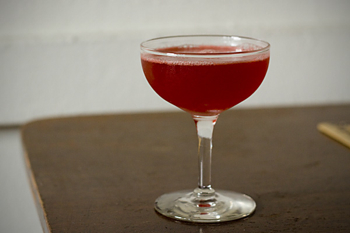Properly Sauced: The Scofflaw
By Roger Kamholz in Food on Oct 3, 2011 6:00PM
 Part two of the three-part miniseries Prohibition premieres tonight on WTTW Channel 11 at 7 p.m. This installment of the latest documentary film by Ken Burns and Lynn Novick chronicles the aftermath of the passage of the 18th Amendment and the Volstead Act, the law that both gave Prohibition enforcement its teeth and unwittingly set in motion a 13-year bender of rampant criminality in America.
Part two of the three-part miniseries Prohibition premieres tonight on WTTW Channel 11 at 7 p.m. This installment of the latest documentary film by Ken Burns and Lynn Novick chronicles the aftermath of the passage of the 18th Amendment and the Volstead Act, the law that both gave Prohibition enforcement its teeth and unwittingly set in motion a 13-year bender of rampant criminality in America.
We kicked off our coverage of Prohibition last week by bringing you a classic pre-Prohibition cocktail recipe - the Corpse Reviver #2 - to accompany your viewing (the 18th Amendment was repealed, after all, in 1933). Today's libation, the Scofflaw, aptly coincides with part two's focus on the era's indelibly nefarious characters. We meet Cincinnati attorney turned criminal kingpin George Remus (said to be the inspiration for Fitzgerald's Jay Gatsby), Seattle's Roy Olmstead, who smuggled untold quantities of booze over the U.S.-Canadian border, and the pièce de resistance of flagrant 1920s gangsterism, Chicago's very own Alphonse Gabriel Capone. These infamous bootleggers helped keep America wet throughout its Noble Experiment as a dry nation.
Both the term scofflaw and the cocktail that bears its name originated during the 1920s. A national contest was held to find a word that best described the newly formed tribe of Americans who habitually flouted or violated the law by, in one way or another, participating in the illicit booze trade. From the 25,000 entrants, top honors went to two individuals who both submitted the same winning entry, which smoothly elides the words "scoff" and "law."
The term was meant to shame lawbreakers, but it was hardly effectual. In fact, it wasn't long before "scofflaw" was co-opted to entitle a cocktail. The Chicago Tribune reported on January 27, 1924, that "Jack, the genial manager of Harry's Bar in Paris, yesterday invented the Scoff-Law Cocktail, and it has already become exceedingly popular among American Prohibition dodgers."
With domestic bourbon production at a standstill, America got flooded during Prohibition with rye whiskey from Canada, where alcohol remained legal. Hence, the Scofflaw - much like the Prohibition drinker - made use of what was available. Lemon and grenadine lend acidity and sweetness to counter the heat and spice of the rye base. In an era of bathtub gin and rotgut moonshine, getting your hands on a Scofflaw must have been something.
The Scofflaw
1 1/2 ounces rye
1 ounce dry vermouth
3/4 ounce fresh lemon juice
3/4 ounce grenadine
Shake all ingredients with ice, and strain into a chilled cocktail glass. Garnish with a twist of lemon.